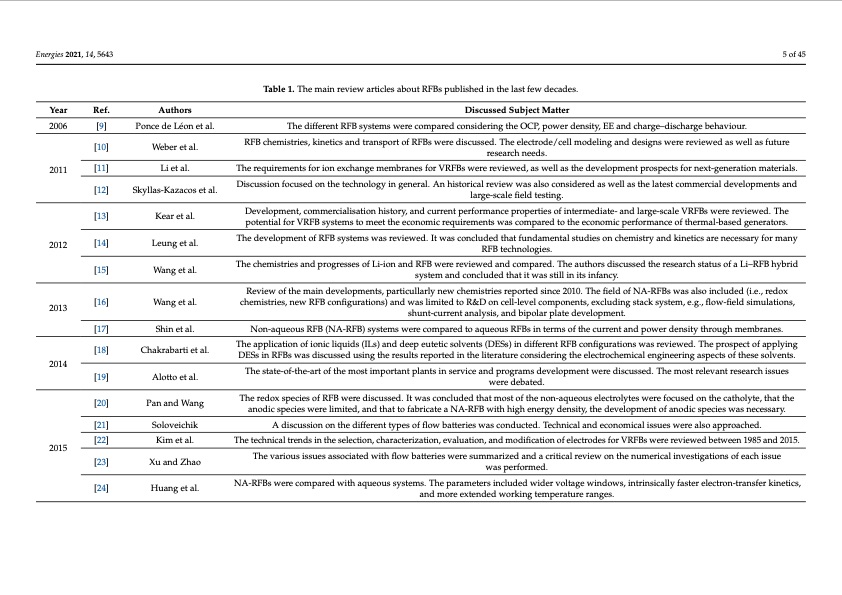
PDF Publication Title:
Text from PDF Page: 005
Energies 2021, 14, 5643 5 of 45 Year 2006 2011 2012 2013 2014 2015 Ref. [9] [10] [11] [12] [13] [14] [15] [16] [17] [18] [19] [20] [21] [22] [23] [24] Authors Ponce de Léon et al. Weber et al. Li et al. Skyllas-Kazacos et al. Kear et al. Leung et al. Wang et al. Wang et al. Shin et al. Chakrabarti et al. Alotto et al. Pan and Wang Soloveichik Kim et al. Xu and Zhao Huang et al. Table 1. The main review articles about RFBs published in the last few decades. Discussed Subject Matter The different RFB systems were compared considering the OCP, power density, EE and charge–discharge behaviour. RFB chemistries, kinetics and transport of RFBs were discussed. The electrode/cell modeling and designs were reviewed as well as future research needs. The requirements for ion exchange membranes for VRFBs were reviewed, as well as the development prospects for next-generation materials. Discussion focused on the technology in general. An historical review was also considered as well as the latest commercial developments and large-scale field testing. Development, commercialisation history, and current performance properties of intermediate- and large-scale VRFBs were reviewed. The potential for VRFB systems to meet the economic requirements was compared to the economic performance of thermal-based generators. The development of RFB systems was reviewed. It was concluded that fundamental studies on chemistry and kinetics are necessary for many RFB technologies. The chemistries and progresses of Li-ion and RFB were reviewed and compared. The authors discussed the research status of a Li–RFB hybrid system and concluded that it was still in its infancy. Review of the main developments, particullarly new chemistries reported since 2010. The field of NA-RFBs was also included (i.e., redox chemistries, new RFB configurations) and was limited to R&D on cell-level components, excluding stack system, e.g., flow-field simulations, shunt-current analysis, and bipolar plate development. Non-aqueous RFB (NA-RFB) systems were compared to aqueous RFBs in terms of the current and power density through membranes. The application of ionic liquids (ILs) and deep eutetic solvents (DESs) in different RFB configurations was reviewed. The prospect of applying DESs in RFBs was discussed using the results reported in the literature considering the electrochemical engineering aspects of these solvents. The state-of-the-art of the most important plants in service and programs development were discussed. The most relevant research issues were debated. The redox species of RFB were discussed. It was concluded that most of the non-aqueous electrolytes were focused on the catholyte, that the anodic species were limited, and that to fabricate a NA-RFB with high energy density, the development of anodic species was necessary. A discussion on the different types of flow batteries was conducted. Technical and economical issues were also approached. The technical trends in the selection, characterization, evaluation, and modification of electrodes for VRFBs were reviewed between 1985 and 2015. The various issues associated with flow batteries were summarized and a critical review on the numerical investigations of each issue was performed. NA-RFBs were compared with aqueous systems. The parameters included wider voltage windows, intrinsically faster electron-transfer kinetics, and more extended working temperature ranges.PDF Image | PNNL Vanadium Redox Flow Battery Stack

PDF Search Title:
PNNL Vanadium Redox Flow Battery StackOriginal File Name Searched:
energies-14-05643-v2.pdfDIY PDF Search: Google It | Yahoo | Bing
Salgenx Redox Flow Battery Technology: Salt water flow battery technology with low cost and great energy density that can be used for power storage and thermal storage. Let us de-risk your production using our license. Our aqueous flow battery is less cost than Tesla Megapack and available faster. Redox flow battery. No membrane needed like with Vanadium, or Bromine. Salgenx flow battery
| CONTACT TEL: 608-238-6001 Email: greg@salgenx.com | RSS | AMP |